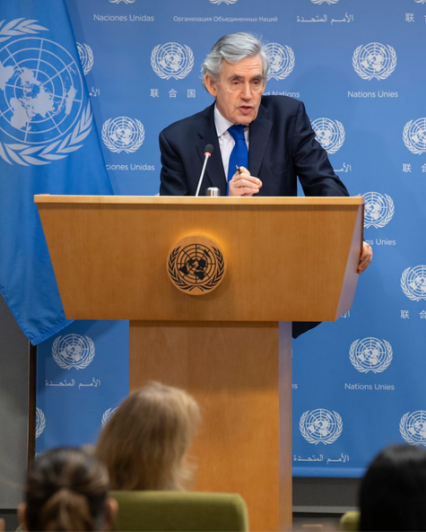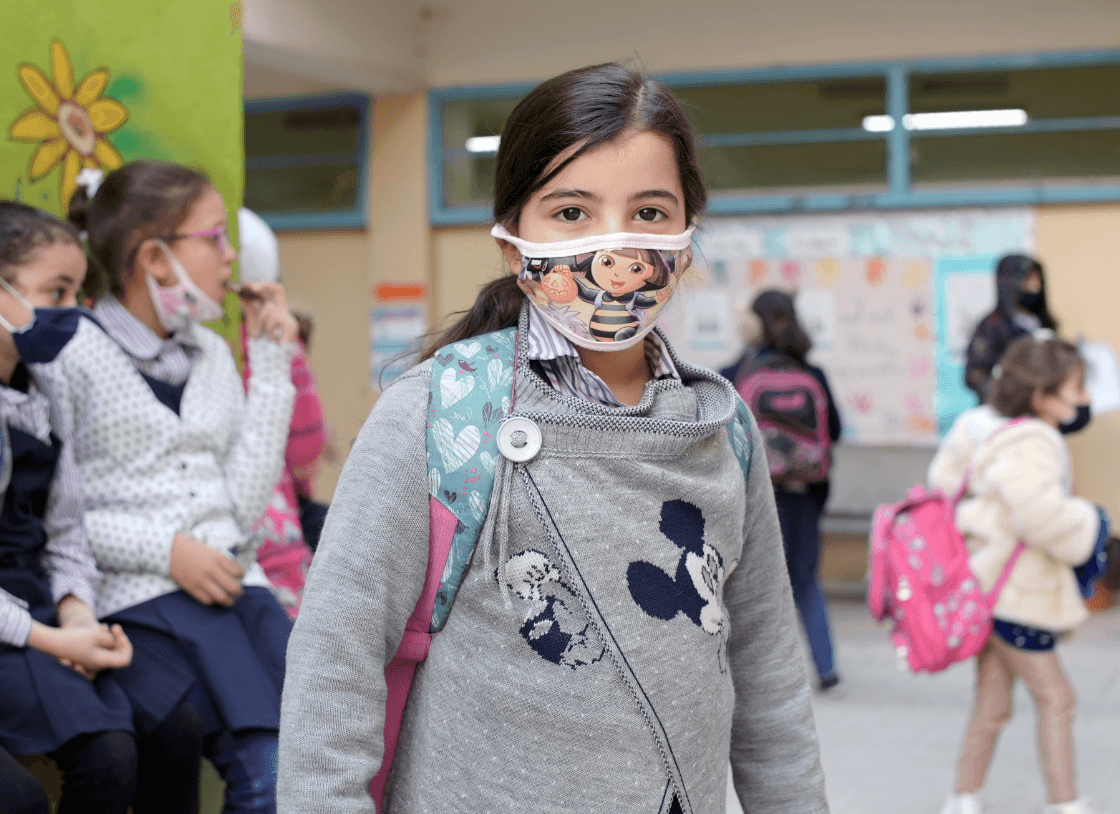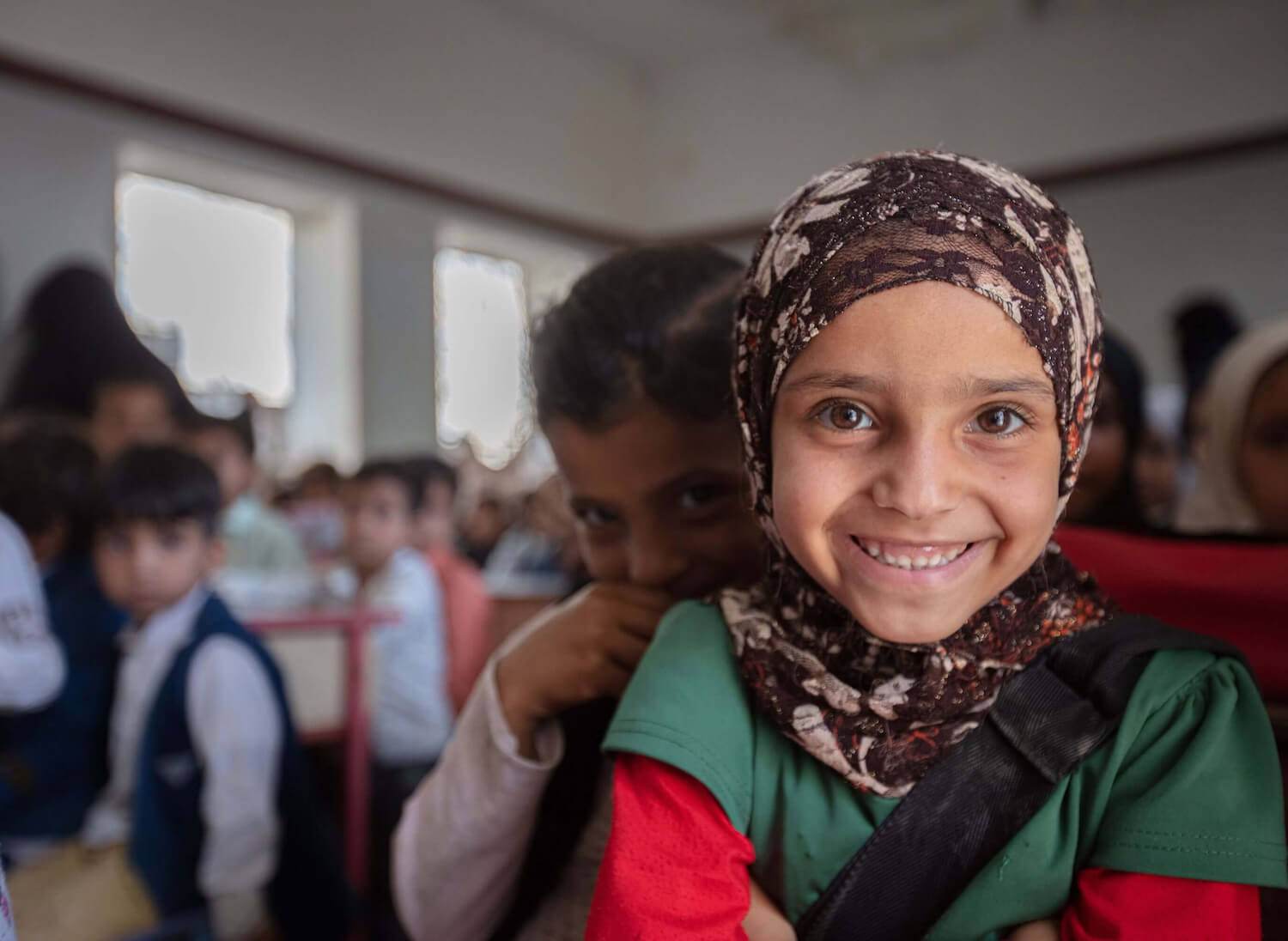© UNICEF/Mulala
Strategic Objectives
ECW’s Strategic Plan measures performance and progress over time against the Fund’s strategic objectives:

1./2.
Inspire
political
support and financing

3.
Improve
joint planning and timely response

4.
Strengthen
capacity to respond

5.
Improve
data, evidence, and accountability
© UNICEF/Mersha

Strategic Objectives 1 and 2
Inspire Political Support and Financing
Inspiring political support and mobilizing funds for education in emergencies and protracted crises are crucial means of achieving ECW’s goal of supporting inclusive, quality education and delivering on SDG 4.

“To be the first generation in history in which each single child goes to school, we must redouble our collective efforts now. Together, we have one reason for acting: to ensure that instead of some children developing some of their potential in some of the world’s countries, all children can develop all their potential in every country.”
The Rt. Hon. Gordon Brown
Chair of the ECW High-Level Steering Group
and UN Special Envoy for Global Education
Education Gains Threatened by the COVID-19 Crisis
COVID-19 has both posed a threat and provided an opportunity for education in emergencies and protracted crises. It has highlighted the centrality of education but also affected overseas development assistance and humanitarian funding for education.
Growth Into an Established Fund
ECW has grown into an established global fund that provides quality education in conflict and crisis settings, thereby contributing to the Sustainable Development Goals. It has done so by using a strong context-specific and crisis-sensitive approach through optimizing existing humanitarian and development coordination structures established in countries affected by armed conflict, forced displacement, climate induced disasters and other crises.
Strengthened Partner Engagement
Despite worrying global trends, ECW maintained its funding performance thanks to strengthened partner engagement and influence from its inception through the end of 2020. ECW mobilized $91.9 million in 2020 for a total of $684.5 million through its trust fund since inception.
Progress Highlights
Total annual funding for education in emergencies as a percentage of global sector-specific humanitarian funding
Proportion of humanitarian appeals that include an education component
*(excluding COVID-19 appeals)
Percentage of countries in protracted crises targeted by ECW with policies regarding inclusion of refugees
Total funding raised and leveraged by ECW at country and global level since inception
*$592.6M global + $120M leveraged in six MYRPs
**$684.5M global + $1,032.5M leveraged in 10 MYRPs
© UNICEF/Mulala

Strategic Objective 3
Improve joint planning and timely response
ECW facilitates joint planning and supports more coherence between humanitarian and development education aid interventions.
Eight New MYRPs
ECW developed eight new MYRPs in 2020, all of which encompass a more strategic focus and ‘whole-of-child’ approach.
Enhancing MYRP Development
ECW enhanced MYRP development processes in 2020 through strengthening alignment to existing national policies and strategies, placing greater emphasis on their use in mobilizing resources and ensuring they were results-based and risk-informed.
Most Rapid Disbursment
In 2020, ECW experienced its most timely deployment of funds yet, with 76% of sudden-onset crisis FERs (including COVID-19 FERs) and 58% of all FERs disbursed within 8 weeks.
Increased Timelines
Timeliness of MYRPs increased to 71% in 2020 due to the implementation of a lighter, more strategic-level approach to programme development.
Progress Highlights
Percentage of FER countries where funds were disbursed up to eight weeks after the humanitarian appeal date
(sudden-onset crisis including COVID-19 FERs)
(58%, all FER
grants)
Percentage of MYRP countries where funds were disbursed up to six months after the country scoping mission
Holistic Programming Components for 8 New MYRPs in 2020

Learning at home:
7 MYRPs

Emotional and psychosocial protection:
8 MYRPs

WASH:
8 MYRPs

Safe and accessible learning spaces:
8 MYRPs

School leadership and management:
7 MYRPs

Parent and community engagement:
4 MYRPs

Health and nutrition:
4 MYRPs

Teacher wellbeing and development:
8 MYRPs

Inclusive and protective policies:
6 MYRPs
© UNICEF/Dejongh

Strategic Objective 4
Strengthen capacity to respond
In building national and local capacity, ECW investments provide education stakeholders with the training, tools, and information they need to deliver effective responses in emergencies and protracted crises.
Scaled-up Remote Support
In response to the pandemic, the Global Education Cluster scaled-up remote support to coordinate, develop and consult members of the education clusters via its help desk, distance support, rapid response teams and online coordination training.
Increased Financial Absorption Capacity
Financial absorption capacity across ECW’s investment portfolio increased to 95%.
Grand Bargain Target
23% of ECW funding was allocated to local and national responders as directly as possible to improve outcomes for affected people and reduce transactional costs, nearly achieving the 25% target of the Grand Bargain commitment.
Technical Innovation
The Humanitarian Education Accelerator adapted well to the COVID-19 pandemic by creating the COVID Amplify Challenge, focusing on technological innovations to meet the challenges of school closures.
Progress Highlights
Percentage of ECW funding allocated to local and national responders as directly as possible in accordance with the Grand Bargain commitment
Percentage of ECW-supported programmes featuring
cash transfers to:
(i) households or students for education, and/or
(ii) schools to improve learning environments

55%
Absorptive capacity: portion of grant budgets reported as spent on services delivered
© UNICEF/Schermbrucker

Strategic Objective 5
Improve data, evidence and accountability
ECW aims to strengthen its systems using data and evidence to support advocacy efforts and to help implement improved interventions across the programming cycle.
MYRP Needs Assessments
To generate good quality evidence for planning, ECW worked closely with the Global Education Cluster to provide specific support to ECW grantees by conducting needs assessments for the development of MYRPs in Colombia, Iraq and Somalia.
Measuring Holistic Learning Outcomes
ECW launched a pilot programme in seven countries that will run until 2022 to develop, test and document fit-for-purpose solutions measuring holistic learning outcomes of children in crisis-affected countries, which is a new requirement for all MYRPs. The initiative has a particular emphasis on the integration and analysis of social and emotional learning (SEL).
Proof of Concept Confirmed
The first independent external evaluation of ECW’s FER investment modality was conducted in 2020. The evaluation found that the FERs were relevant to education in emergency needs, particularly when used in rapid-onset and escalating emergencies. The evaluation further confirmed the FER model’s proof of concept and the validity of the theory of change.
Progress Highlights
Percentage of ECW-supported programmes measuring affected communities’ access to education
Percentage of ECW-supported MYRPs having quality data on learning outcomes (excluding SEL)


